Our choice of orbits can create scientifically useful space missions that can be operated at lower cost than their more conventional counterparts. How this has been done and the kind of missions it could enable in the future is the subject of James Jason Wentworth’s essay. An amateur astronomer and interstellar travel enthusiast, Wentworth worked at the Miami Space Transit Planetarium and volunteered at the Weintraub Observatory atop the adjacent Miami Museum of Science. Now making his home in Fairbanks (AK), he was the historian for the Poker Flat Research Range sounding rocket launch facility. His space history and advocacy articles have appeared in Quest: The History of Spaceflight magazine and Space News.
by J. Jason Wentworth
In the 1990s, then NASA Administrator Daniel S. Goldin introduced the “Better, Faster, Cheaper” paradigm for space missions. While NASA’s subsequent experiences led many engineers to modify that to “Better, Faster, Cheaper–choose two,” the goal of low cost has remained a primary goal for space mission planners. One way to reduce the cost of a mission is to select a trajectory that requires the least possible change of velocity (called Delta-V by engineers and orbital dynamicists) to achieve the mission’s objectives. This requires less propellant aboard the spacecraft, which results in a smaller and lighter spacecraft, which in turn can usually be lofted by a smaller and less expensive launch vehicle. (Very high-energy missions such as New Horizons are exceptions. In such cases, launching the smallest possible spacecraft merely makes such missions possible within a practical flight duration–even when using the most powerful launch vehicles available–because the velocities required for even the lowest-energy trajectories are so high.)
Another factor that affects the spacecraft’s required amount of onboard propellant is the stability of the mission orbit. If frequent orbital adjustments are necessary for any reason, a larger propellant reserve will be required, which will bump up the probe’s size and mass. The type of spacecraft stabilization system that is used also has an influence on the propellant reserve. A three-axis stabilized probe in orbit around the Moon, the Sun, another planet, or any other body will require more thruster firings (to point its sensors and imaging system at its target body, and to aim its high-gain antenna at Earth) than will a spin-stabilized spacecraft, so the latter can operate for many years using very little propellant for attitude control.
The spin-stabilized Pioneer spacecraft all exhibited this characteristic of very long life. Perhaps the most impressive of the series (besides the Sun-orbiting Pioneer 6 – 9 interplanetary probes, which lasted for multiple decades; two of them may still be functioning) was the Pioneer Venus Orbiter, which returned images of and data on the planet (and Comet Halley) for nearly 14 years, in the hostile thermal and solar radiation environment around Venus. [1] In March of 1986 Pioneer 7 also flew within 12.3 million kilometers (7.6 million miles) of Halley’s Comet and monitored the interaction between the cometary hydrogen tail and the solar wind. It discovered He+ plasma produced by charge exchange of solar wind He++ with neutral cometary material. [2]
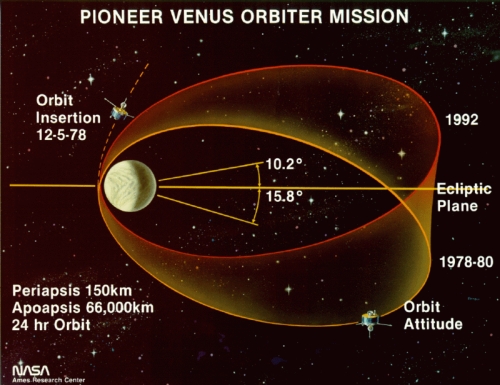
Image: Orbit attitude of Pioneer Venus 1 between 1978 – 1980 and 1992. Credit: NASA/Ames.
Since the space age began, other trajectories besides the classical Hohmann transfer ellipse have been devised to get satellites and space probes to their destination orbits or worlds. These are used to minimize the necessary Delta-V, or to optimize planet arrival times, or both. Some geosynchronous satellites are now first injected into “super-synchronous” transfer orbits from their initial low-altitude parking orbits, from which they are later maneuvered downward into their 24-hour operational orbits. The Pioneer Venus Orbiter traveled along a similar path to Venus; it was boosted from its parking orbit around the Earth into a solar orbit that initially passed outside the Earth’s orbit about the Sun before curving inward to intercept Venus in its orbit.
Other unusual types of orbits exist, some of which were discovered when asteroids were found to be moving in them, and they are also useful for low-Delta-V (and thus lower cost) space missions. The best-known ones are halo orbits and the tadpole-shaped Lissajous orbits, in which several spacecraft have traveled around the Sun-Earth L1 and L2 Lagrangian points and the Earth-Moon L1 and L2 points.
Enter the Horseshoe Orbit
A more recently-discovered path (which a 2011 Centauri Dreams article, Stable Orbit for a Newly Discovered Companion, discusses) is the horseshoe orbit, which got its name from its shape. [3] A small object in such an orbit goes around the Sun in a normal, low-eccentricity (close to circular) elliptical orbit in the direct (prograde) direction, but since its orbit has nearly the same period and shape as the orbit of a nearby planet (Earth, in the case of the horseshoe-orbiting asteroids discovered to date), gravitational interactions with Earth create the horseshoe path (which occurs only in the Earth-centered reference frame, as the asteroid orbits around the Sun normally). This celestial “dance” works as follows:
As the asteroid is about to pass the Earth in its slightly lower, more rapid orbit, the Earth’s gravity pulls it toward itself; this speeds up the asteroid, which causes it to move farther from the Sun (and thus into a higher orbit), and this then causes the asteroid to slow down, because objects in higher orbits move more slowly. In its higher, slower orbit, the asteroid then begins to drop behind the Earth, slowly “drifting” backwards all the way around the Sun (from the Earth’s perspective–the asteroid is orbiting the Sun in the same direct [prograde] direction as Earth, just more slowly). Many years later, as the asteroid again approaches Earth (from ahead of our planet this time), the Earth’s gravity slows down the asteroid, which causes it to fall into a lower, faster orbit around the Sun. Now moving faster than the Earth (inside Earth’s orbit), the asteroid slowly “drifts” all the way around the Sun again (moving forward this time, from Earth’s perspective), after which it repeats the whole horseshoe orbit cycle again. [4]

Image: A horseshoe orbit, showing possible orbits along gravitational contours. In this image, the Earth (and the whole image with it) is rotating counterclockwise around the Sun. Credit: Wikimedia Commons.
While other asteroids in horseshoe orbits with respect to Earth have been found before, their orbits aren’t long-term stable. Within a certain range of distances, orbital eccentricities, and velocities, however, stable horseshoe orbits are possible, and the asteroid 2010 SO16 (the subject of the Centauri Dreams article in Reference 3) is in one, having possibly followed its current orbit for up to two million years. In addition, it is possible–as 2010 SO16 might have done, as is mentioned in the article–for asteroids (or other objects, such as spacecraft) to librate (migrate) from Lissajous orbits around the Sun-Earth L4 or L5 Lagrangian points into stable horseshoe orbits. Migration from a horseshoe orbit back into a Lissajous orbit might also be possible, and what an unpowered asteroid could do, a self-powered space probe could likely also do–using little propellant.
Another unusual kind of orbit is the quasi-satellite orbit, in which NEAs (Near-Earth Asteroids) have also been discovered. [5] A quasi-satellite is in an orbit around the Sun that has a 1:1 resonance with the orbit of a particular planet. This causes the quasi-satellite to stay close to that planet over many orbital periods. A quasi-satellite’s orbit has the same period as the planet’s orbit, but the quasi-satellite’s orbit has a different–usually greater–eccentricity than the planet’s orbit. As observed from the planet, the quasi-satellite appears to move in an oblong retrograde loop around the planet, although both bodies are orbiting the Sun in direct (prograde) orbits.
Orbital Dynamics and ‘Fuzzy Boundaries’
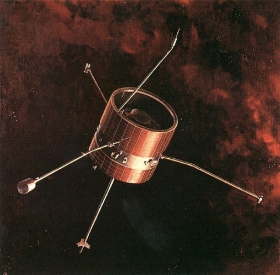
Pioneer E (which would have been named Pioneer 10 if it had not been lost in its failed launch on August 27, 1969) was the fifth and last of the series of solar-powered, drum-shaped Sun-monitoring interplanetary probes that began with Pioneer 6 in December of 1965, and Pioneer E was intended to orbit the Sun as a quasi-satellite of Earth. Had it reached its planned solar orbit, Pioneer E (which was launched–and lost–with the TETR C test and training satellite, the intended third “practice” satellite for the Apollo tracking and communications network) would have passed inside and outside the Earth’s orbit, alternately speeding up and slowing down relative to Earth. This would have kept Pioneer E within 16 million kilometers (10 million miles) of Earth during the spacecraft’s design lifetime of from six months to two and one-half years. [6] (It would likely have operated for much longer than two and one-half years, as its sister probes Pioneer 6 – 9 demonstrated.)
Image: Artist’s conception of the Pioneer 6-9 spacecraft. Credit: NASA.
Orbit changes could be done using even less propellant (virtually none, in some cases) by employing Dr. Edward Belbruno’s principle of gravitational “Fuzzy Boundaries,” which involve the physics of chaos. [7, 8, and 9] This was first demonstrated in 1991 after Japan’s first lunar probe, the combined Hiten/Hagoromo spacecraft, ran into difficulties. Launched on January 24, 1990, the craft was injected into a highly-eccentric elliptical Earth orbit that passed beyond the Moon. The tiny Hagoromo lunar orbiter separated from Hiten during its first lunar swing-by and fired its solid propellant retro-rocket as the vehicles passed the Moon; while Hagoromo entered lunar orbit as intended, its radio transmitter failed when its retro-rocket fired (optical telescopic observation from Earth confirmed its entry into lunar orbit), which rendered it scientifically useless. [10] On March 19, 1991, Hiten performed the first-ever aerobraking maneuver, skimming the Earth’s atmosphere to change its orbit.
Having learned of Hagoromo’s transmitter failure, Edward Belbruno approached ISAS (the Institute of Space and Aeronautical Science) and offered to help them get their still-functioning Hiten lunar flyby spacecraft into lunar orbit. The probe, which was in a highly-eccentric Earth orbit, was moving much too fast during its lunar flybys to brake into lunar orbit using its onboard propellant. But by utilizing his “Fuzzy Boundaries” method, which involved using the combined gravity of the Moon and the Earth, on October 2, 1991 Hiten’s flight controllers were able to maneuver the probe into a preliminary, temporary lunar orbit using almost no propellant. After that, Hiten was targeted to fly through the Earth-Moon L4 and L5 points to collect data on any meteoric dust that was thought to possibly have accumulated there (none was detected). On February 15, 1993, Hiten was directed into a permanent lunar orbit, where it remained until it was deliberately crashed on the lunar surface on April 10. [11]

Image: An artist’s conception of the Hiten spacecraft. Credit: JAXA.
A Panoply of Applications
Stable horseshoe solar orbits and quasi-satellite solar orbits–entered and/or exited with the aid of Dr. Belbruno’s “Fuzzy Boundaries” method, making use of planetary as well as solar gravity–would be useful for Pioneer 6 – E type solar monitoring probes, which could observe portions of the Sun that cannot be seen (at any given time) from Earth. They could also, in concert with solar observations from Earth (or from Earth satellites), make stereo observations of solar features at many places along their horseshoe or quasi-satellite orbits. These same solar probes could also, as the Sun-orbiting Pioneer 7 interplanetary probe did, encounter and examine comets that pass through or near their orbits (flybys of asteroids that pass them would also be possible). If necessary, such probes could modify their horseshoe or quasi-satellite orbits (speeding up or slowing down, as needed) in order to make closer flybys of comets and asteroids (and later return to their original orbits) using very little propellant. Or, the probes could utilize solar sail propulsion (a simplified heliogyro sail should work nicely) to make such orbit changes, using no propellant at all.
Another application for horseshoe and quasi-satellite solar orbits would be to place NEO (Near-Earth Object) space telescopes in such orbits, much closer to the Sun than Earth’s distance. These locations would enable the spacecraft to see Earth-crossing NEOs whose orbits keep them mostly inside Earth’s orbit, and objects that could become dangerous to Earth in the future (via gravitational encounters with Venus and/or Mercury) would also be visible to these spacecraft. (To telescopes on or near the Earth, the sunlit sides of these small, often dark-colored objects face away from our planet, making them virtually impossible to see in the Sun’s glare, and Earth-based telescopes could never search for them in a truly dark sky because they would never be far from the Sun.) The B612 Foundation and its aerospace industry partner Ball Aerospace plan to send their NEO-seeking Sentinel space telescope to a Venus-like solar orbit for this reason. [12 and 13]. A horseshoe orbit or a quasi-satellite orbit “threaded around” Venus’ orbit about the Sun could reduce the necessary Delta-V (and thus the spacecraft’s launch vehicle and onboard propellant requirements) by utilizing Venus’ gravity to help establish–and later maintain by itself–either type of orbit for the Sentinel spacecraft.
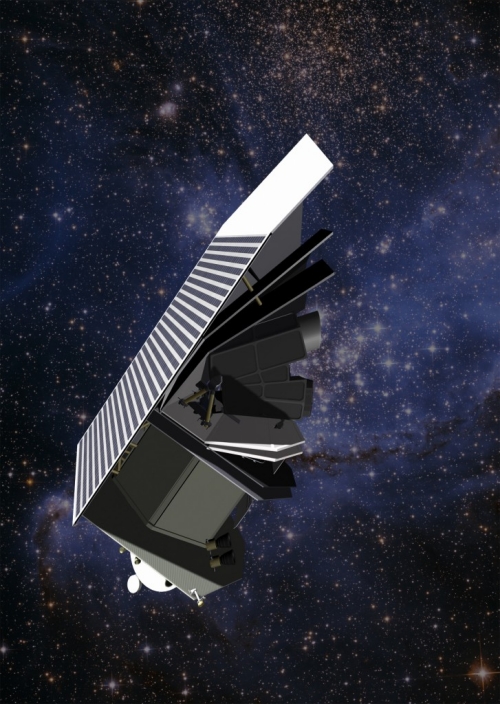
Image: The Sentinel Space Telescope, being built by the B612 Foundation. Credit: B612Julie (Own work) [CC BY-SA 4.0 (http://creativecommons.org/licenses/by-sa/4.0)], via Wikimedia Commons.
Closer to home, Earth-centered horseshoe orbits–in which evenly-spaced communication, weather, or Earth resources satellites could “cycle” around the Earth as if on a circular conveyor belt (with two sets of spacecraft, on the inner and outer edges of the “belt”)–could provide global coverage not only of Earth, but they could also serve as communication relays for the lunar farside and for the Earth-Moon L2 point behind the Moon. (For circum-terrestrial horseshoe orbits, the Moon’s gravity would serve the same function that the Earth’s gravity does for Sun-centered horseshoe orbits that are “threaded around” Earth’s orbit about the Sun.) They could also provide close-up lunar observation to monitor time-variant lunar phenomena (the lunar “dustosphere’s” monthly cycling under the influence of Earth’s magnetotail, lunar meteorite impacts during meteor showers, TLP [the luminous Transient Lunar Phenomena], etc.).
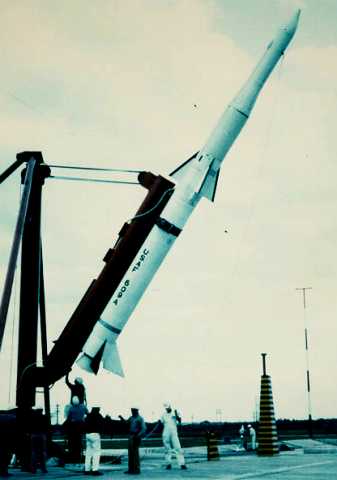
Surprisingly, even low-cost suborbital interplanetary missions are possible. In addition to gathering data on the time-variant phenomena of the interplanetary environment, they could also collect dust, ice, and gas samples from comets that pass relatively close to Earth. NASA’s simple, inexpensive solid propellant Scout satellite launch vehicle, manufactured by LTV (Ling-Temco-Vought) using existing “off-the-shelf” rocket motors, was also used for several high-altitude suborbital probe missions that reached tens of thousands of kilometers into space. [14] (A rocket that ascends to an altitude of one Earth radius or higher is considered a space probe rather than a sounding rocket, because reaching one Earth radius requires a rocket velocity that is equal to Low Earth Orbit [LEO] orbital velocity.) The U.S. Air Force’s Blue Scout vehicles (which were similar to the NASA Scout vehicles for the most part, but were somewhat different because they were produced by a different contractor, the Ford Motor Company’s Aeronutronic Division) also flew numerous probe missions. [15 and 16] One in particular, a Blue Scout Junior launched from Cape Canaveral on August 17, 1961, reached an altitude of 225,000 kilometers (140,000 miles)–more than halfway to the Moon–on a suborbital flight lasting days. Unfortunately, the payload’s transmitter failed during the final (fourth) stage’s burn, rendering the flight scientifically useless. [17 and 18]
Image: The Blue Scout Junior. Credit: Peter Alway/Encyclopedia Astronautica: http://www.astronautix.com/index.html.
In his 1957 book The Making of a Moon: The Story of the Earth Satellite Program (and in its 1958 post-Sputnik revised second edition), Arthur C. Clarke pointed out that by launching suborbital vehicles at velocities approaching Earth’s escape velocity, their payloads could reach altitudes of millions of miles before falling back to Earth. [19] Interestingly, the altitudes achieved begin to increase dramatically at only 35,000 kilometers per hour (22,000 miles per hour), significantly below Earth’s escape velocity. As he wrote: “A rocket launched vertically at 22,000 miles an hour–or four thousand miles an hour faster than a satellite–would reach an altitude of about fifteen thousand miles before gravity checked its speed and it fell back to Earth. Slight further increases in velocity would give altitudes of millions of miles, until at the critical speed of 25,000 miles an hour the rocket never came back at all.”
Such vehicles could be very small–the 7.3-meter (24-foot) long, balloon-launched Project Farside probe rockets of the late 1950s, which reached nearly orbital velocity and rose to altitudes of between 3,200 and 5,000 kilometers (2,000 and 3,100 miles) with 1.4 to 3.3 kilogram (3 to 5 pound) payloads, could have reached the vicinity of the Moon with the addition of a fifth stage, which was proposed. [20] But this proposal was not proceeded with, possibly because the electronics technology of those days likely wouldn’t have enabled such small payloads to return meaningful data from the Moon’s distance (the frequent failures of the Farside vehicles’ payload transmitters also didn’t encourage much confidence in more ambitious ventures). But today a full suite of instruments, an S-band or X-band telemetry transmitter, and their solar cell or battery power supply could be accommodated in payloads of that mass range.
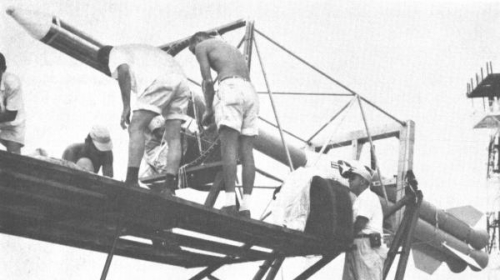
Image: Working on Project Farside. Credit: Parsch, Directory of U.S. Military Rockets and Missiles: http://www.designation-systems.net/dusrm/app4/farside.html.
Existing high-performance multi-stage sounding rockets could, if topped with multiple high-velocity stages, boost heavier payloads to such velocities (similar vehicles have boosted artificial meteors to velocities far in excess of escape velocity, beginning in 1957). [21 and 22] Such “souped-up” sounding rockets, or small–particularly air-launched satellite launch vehicles with additional upper stages, such as Orbital Sciences Corporation’s Pegasus XL and the upcoming Boeing ALASA (Airborne Launch Assist Space Access) system–could loft small suborbital interplanetary probes. [23 and 24] This capability would make possible low-cost, rapid comet sample return missions to “targets of opportunity,” comets such as IRAS-Araki-Alcock and Hyakutake that pass within a few million kilometers of Earth.

Image: The Pegasus XL launch vehicle operated by Orbital Sciences Corporation. Credit: NASA.
The recoverable portion of the spacecraft could use a deployable aerogel particle collector that would be housed in a small, blunt re-entry heat shield similar to that of the Pioneer Venus Small Probes or the Japanese Hayabusa and Hayabusa 2 asteroid sample return probes. The expendable section of the spacecraft, which would burn up upon re-entry into the Earth’s atmosphere, would carry fields and particles instruments and an imaging system. At other times, such suborbital probes could collect intact meteoroids from meteor shower streams for return to Earth, and/or they could gather data on the far regions of Earth’s magnetosphere and magnetotail, including their interactions with the solar wind and the solar magnetic field. Since the parent bodies of many meteor shower streams are now known (most originate from comets–a few are from asteroids), suborbital probes would offer inexpensive, frequent, and regular opportunities for collecting samples of these objects.
By substituting subtlety and cleverness for brute force, and by letting some mission targets come to their probes more than vice-versa, many new, scientifically useful, and inexpensive space missions would become practical and affordable. In addition to garnering new knowledge, such missions would also provide more frequent opportunities for young scientists, engineers, and orbital dynamicists to gain hands-on experience in designing and executing deep space missions–experience that would be of great help to them when the time comes to tackle the more ambitious outer solar system and observatory missions that NASA hopes to fly in the coming decades.
——-
References
1. Pioneer Venus Project Information, National Space Science Data Center website: http://nssdc.gsfc.nasa.gov/planetary/pioneer_venus.html
2. Pioneer 6, 7, 8, and 9, Wikipedia article: https://en.wikipedia.org/wiki/Pioneer_6,_7,_8,_and_9
3. Stable Orbit for a Newly Discovered Companion, Centauri Dreams article: https://centauri-dreams.org/?p=17484
4. Horseshoe orbit, Wikipedia article: https://en.wikipedia.org/wiki/Horseshoe_orbit
5. Quasi-satellite, Wikipedia article: https://en.wikipedia.org/wiki/Quasi-satellite
6. TRW Space Log, Winter 1969-70, Vol. 9, No. 4, Pioneer E, TETR C entry on pages 40 – 43.
The National Space Science Data Center http://nssdc.gsfc.nasa.gov/ has a Pioneer E mission page at http://nssdc.gsfc.nasa.gov/nmc/spacecraftDisplay.do?id=PIONE.
7. Edward Belbruno, Wikipedia article: https://en.wikipedia.org/wiki/Edward_Belbruno
8. Edward Belbruno : Mathematics, Astrophysics, Aerospace Engineering (Edward Belbruno’s Official Website): www.edbelbruno.com
9. SpaceRoutes.com website: http://www.spaceroutes.com/intro.html
10. Hiten (Muses-A) JAXA webpage: http://www.isas.jaxa.jp/e/enterp/missions/hiten.shtml
11. Hiten, Wikipedia article: https://en.wikipedia.org/wiki/Hiten
12. Sentinel Space Telescope, Wikipedia article: https://en.wikipedia.org/wiki/Sentinel_Space_Telescope
13. Sentinel Mission website (mission overview page): http://sentinelmission.org/sentinel-mission/overview/
14. LTV (Vought) SLV-1 Scout, Designation Systems article: http://www.designation-systems.net/dusrm/app3/lv-1.html
15. Ford RM-89 Blue Scout I, Designation Systems article: http://www.designation-systems.net/dusrm/app1/rm-89.html
16. Ford RM-90 Blue Scout II, Designation Systems article: http://www.designation-systems.net/dusrm/app1/rm-90.html
17. Ford RM-91 Blue Scout Junior, Designation Systems article: http://www.designation-systems.net/dusrm/app1/rm-91.html
18. Blue Scout Jr, Encyclopedia Astronautica article (with launch chronology): http://www.astronautix.com/lvs/bluoutjr.htm
19. The Making of a Moon: The Story of the Earth Satellite Program by Arthur C. Clarke, pages 149 – 150 (First Edition, Published 1957 by Harper & Brothers Publishers, New York, NY, Library of Congress catalog card number: 57-8187 [a post-Sputnik revised edition, the same book with that update, was published in 1958])
20. Aeronutronics Farside, Designation Systems article: http://www.designation-systems.net/dusrm/app4/farside.html
21. Possible Challenge to Sputnik on Unmanned Spaceflight website: http://www.unmannedspaceflight.com/lofiversion/index.php/t1955.html
22. The First Shots Into Interplanetary Space by Professor Fritz Zwicky, California Institute of Technology Library website: http://calteches.library.caltech.edu/181/1/zwicky.pdf
23. Boeing to Design DARPA Airborne Satellite Launch Vehicle, Boeing.com website: http://www.boeing.com/features/2014/03/bds-darpa-contract-03-27-14.page
24. DARPA’s ALASA space launch system from airplane, wordlessTech.com website: http://wordlesstech.com/darpas-alasa-space-launch-system-from-airplane/



@Hop David October 27, 2015 at 15:42
‘An ion engine route not using ballistic capture is 6 km/s (from a 1 A.U. circular heliocentric orbit to a 1.52 A.U. heliocentric orbit). An ion engine route using ballistic capture is 5.7 km/s (from a 1 A.U. circular heliocentric orbit to the ballistic capture path).The savings is .3 km/s. When your exhaust velocity is 30 km/s, a .3 km/s savings is practically nothing.’
The savings for the mission is over the WHOLE delta V change, the ion engine is much more efficient than the chemical engine by a factor of around 5, all told, just it takes more time because of the low thrust.
He is speeding things up or reducing the energy needed by looking for and finding (mathematic) paths using the weak stability boundaries.
Not sure what you mean by “the WHOLE delta V change”.
Are you talking about LEO to LMO? If that’s the case, ion engines take a LOT more delta V than chemical. It takes about 6 km/s to get from LEO to earth escape, another 6 km/s to get from a 1 A.U. heliocentric orbit to a 1.52 A.U. heliocentric orbit and then another 3 km/s to spiral down to a low Mars orbit. That’s a total of around 15 km/s.
For chemical, LEO to LMO is about 6 km/s.
Ion engines can give more payload in spite of higher delta V budget. But this is becuase of higher exhaust velocity. As I mentioned, Belbruno deserves no credit for an ion engine’s high exhaust velocity.
Over the entire delta V budget, the ballistic Mars capture saves maybe .3 km/s. Again, an inconsequential savings if your exhaust velocity is 30 km/s.